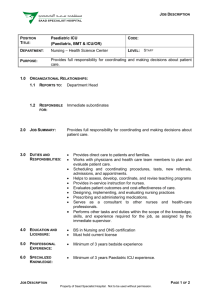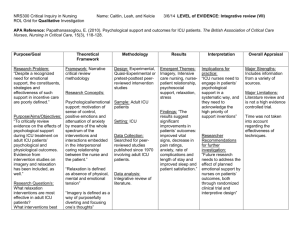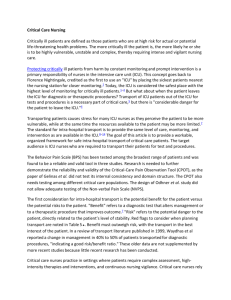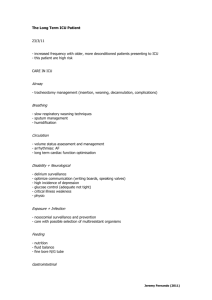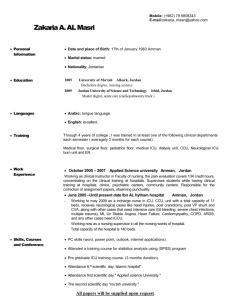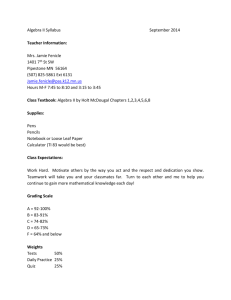7B FOTHERBILL, MALONE TUCKER Transitioning 4th Year Students
advertisement
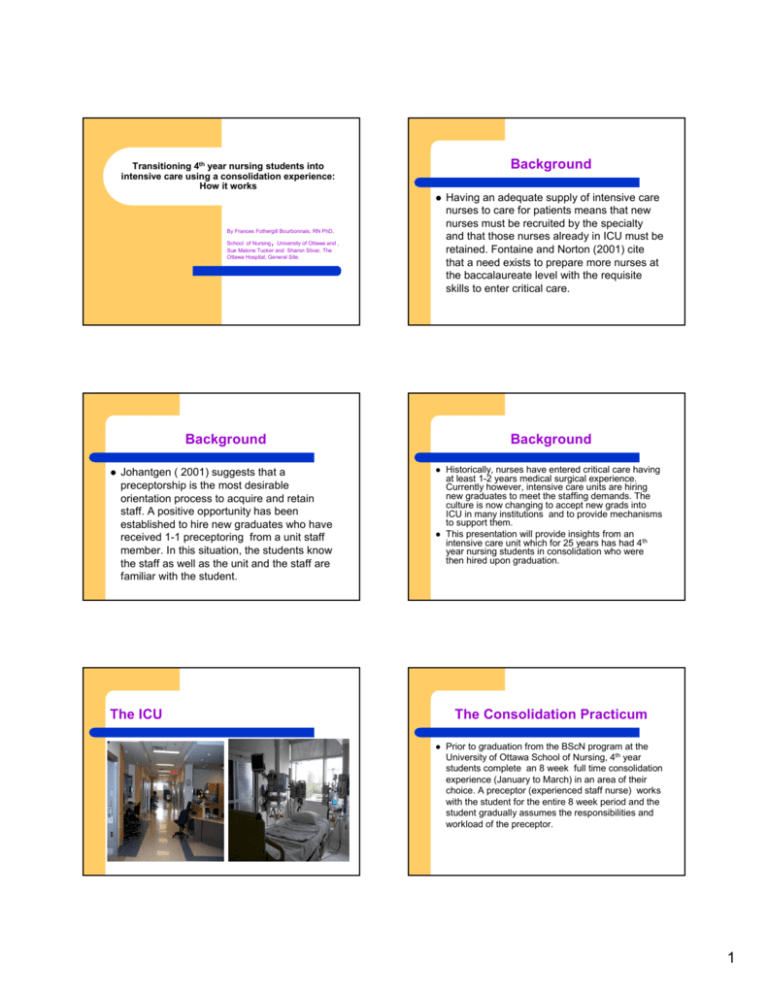
Background Transitioning 4th year nursing students into intensive care using a consolidation experience: How it works By Frances Fothergill Bourbonnais, RN PhD, , School of Nursing University of Ottawa and , Sue Malone Tucker and Sharon Slivar, The Ottawa Hospital, General Site. Background Johantgen ( 2001) suggests that a preceptorship is the most desirable orientation process to acquire and retain staff. A positive opportunity has been established to hire new graduates who have received 1-1 preceptoring from a unit staff member. In this situation, the students know the staff as well as the unit and the staff are familiar with the student. Having an adequate supply of intensive care nurses to care for patients means that new nurses must be recruited by the specialty and that those nurses already in ICU must be retained. Fontaine and Norton (2001) cite that a need exists to prepare more nurses at the baccalaureate level with the requisite skills to enter critical care. Background The ICU Historically, nurses have entered critical care having at least 1-2 years medical surgical experience. Currently however, intensive care units are hiring new graduates to meet the staffing demands. The culture is now changing to accept new grads into ICU in many institutions and to provide mechanisms to support them. This presentation will provide insights from an intensive care unit which for 25 years has had 4th year nursing students in consolidation who were then hired upon graduation. The Consolidation Practicum Prior to graduation from the BScN program at the University of Ottawa School of Nursing, 4th year students complete an 8 week full time consolidation experience (January to March) in an area of their choice. A preceptor (experienced staff nurse) works with the student for the entire 8 week period and the student gradually assumes the responsibilities and workload of the preceptor. 1 Consolidation in ICU Structure: Students at University of Ottawa who select to go to the ICU need to meet the following criteria: a minimum of a B+ grade point average and references from previous clinical teachers who attest to their ability to function in this environment. As well the student must be functioning well in theory and in clinical in the fall of 4th year. Structure of the experience Structure of the experience. The faculty advisor role in ICU. Preparing Preceptors. The Ottawa Hospital provides a workshop to prepare preceptors for their role. In addition, FFB meets with each preceptor in the ICU to review the objectives of the consolidation experience, as well as discuss the theoretical content with which students come such as care of patients with traumatic brain injury and multiple trauma. Structure of the experience. The faculty advisor role in ICU: Preparing preceptors Expectations of students in ICU and skills they can perform are reviewed. Preceptors also protect the student by supporting their student presence in ICU, walking with them through situations such as withdrawal of life support Structure of the experience Preparing preceptors Preceptors always state that the 4th year students come with a strong knowledge base of medical and surgical nursing and the preceptor is then able to help the student to transfer that knowledge into ICU context. The faculty advisor: Professors are assigned to work with the students and preceptors throughout the consolidation experience. In the case of ICU, the 1st author (FFB) has been the faculty advisor with students at the General site for over 20 years. FFB has experiential base in intensive care nursing and teaches all the medical surgical content taught to 4th year students in fall semester. Structure of the experience Preparing Students: Self- directed activities are combined with hands on and theoretical content prior to commencement of the experience with the preceptor. For example, a self directed module on cardiac arrhythmias is accompanied by a lecture on basic arrhythmias such as sinus bradycardia and atrial fibrillation as well as opportunity to work with rhythm strips to learn how to measure intervals etc 2 Structure of the experience Preparing students. They are given a study and observation guide which asks students to answer various questions related to patient and family care such as maintaining sleep, resources for families as well questions pertaining to the organizational structure of the unit and the interprofessional team. Structure of the experience Ventilators are introduced at an introductory level and students are taken to the bedside to observe one in use. The ventilator is broken down into fundamentals so that students understand the basics with terms they already know such as tidal volume. Then look at what volume cycled ventilators do and some basic modes such as PEEP. Issues of safety must be understood. Ethical and legal issues related to ICU are introduced such as withdrawal of care Family care is emphasized. Interprofessional Team Structure of the experience Preparing Students : FFB orients students to the unit which includes the following activities: introduction to nursing and medical staff as well as clinical educators ( SMT, SS, ) and clinical manager The flow of care is examined and charting methods are explored. A simulator mode is used to explain the monitoring system used in the unit and students learn basic functions. Process: Ongoing work of the Faculty Advisor in ICU Link with educators to discuss possible in-services that students could attend Meet with preceptor and students at least weekly to discuss student progress and address any questions or concerns Review with the student, at the bedside, the patient’s condition, goals for care, student learning needs, help students sort through ethical and legal issues and family concerns. Ensure that students contribute in patient rounds and other activities with interprofessional team. Process: Ongoing work of the clinical educators and manager Meet on informal basis with preceptors to discuss how experience is proceeding Meet with students to discuss the experience and advise them of learning opportunities Meet with faculty advisor to review progress of the experience. 3 Outcomes of the experience Process: ongoing work of the students Students prepare personal objectives for the experience (an expectation of all consolidation students in all settings). The preceptor and faculty advisor approve the objectives. These objectives as well as course objectives must be met by the end of the experience. Students must demonstrate tangible evidence of their ability to assess and manage patients at a beginning level and apply an ever expanding knowledge of patient situations. Outcomes of the experience Students learn about: how ICU functions –the flow of work how patient care is dependent on the expertise of a team the interprofessional work environment and in particular the nurse physician relationship in ICU. the importance of communication- eg. oral patient reports Outcomes of the experience Outcomes of the experience Comments from preceptors have been favorable and included statements that reflect: ‘these guys are ready- we should hire them’ or ‘they are ready to rock and roll’ Comments from the medical staff have been favorable as they have watched the students grow in confidence and competence. Students are able to maintain their basic nursing skills and knowledge such as skin care as these skills are extremely important in the ICU setting. Complex skill learning such as suctioning a patient on a ventilator is done over a 12 hour shift and the student will have opportunity to practice this skill many times in that time period. Over the time frame of this ICU consolidation experience, 4th year students have been hired as staff either directly upon graduation or within a few months. Experiential learning of the authors indicates that the best approach is to hire them directly upon graduation so that their learning continues to move forward. Outcomes of the experience It is a privilege to send students to these environments and ongoing work must be done to ensure a safe experience for patients and staff. Students who have had the opportunity for this experience and who are hired, provide peer support for other students who come to ICU. 4 Conclusion Few factors are as important for students in learning to nurse as the clinical learning environments to which they are exposed. (Palmer et al 2005). Staff nurse attitudes in this unit contribute to a positive clinical learning environment which includes warmth and support, gaining access to learning experiences, and the willingness of staff to teach students. Conclusion Conclusion Over the years there have been isolated staff who did not believe that new grads should come to ICU. However, with over 20 years experience in this particular ICU, it became an expectation that students would be coming and there was disappointment if there was only one instead of the usual four students. Educators look to these students as future staff. From Student to RN First Cohort (2006) TOH linked with community college(BCIT/ Algonquin) Hired 13 new grads(different programs) I failed;2 required a learning plan Total number of orientees 2006 17 nurses 82%(14) new grads 18% (3) experience RNs 2 new grads left( May 2007 & June 2008) Socialization into the unit is extremely important. Students must feel they are supported, valued and appreciated. Much work goes into students developing a strong professionally based identity. Student experiences in ICU are a collaborative effort of the faculty advisor and clinical educators, clinical manger and nursing and medical staff. It is our role to help these consolidation students to understand the work of a nurse in critical care. Conclusion The authors long experience with 4th year students in ICU have concluded that this is a valuable experience for everyone concerned and that graduates meet and exceed expectations of staff. The experience works because a concerted effort has been made to welcome students to this unit and support them through their learning. From Student to RN Second Cohort (2007) TOH & HI partnership with Algonquin Combination new grads & experienced nurses Hired 18 nurses 3 new grads( ICU consolidation program) 3 RN’s failed program 1 RN returned to floor Total number of orientees for 2007 31 nurses 10%(3) new grads 10% (3) previous CC experience 80%(25) experienced RN’s June 2008-one new grad left 5 From Student to RN Third Cohort (2008) TOH & HI In House CC program New grads ONLY Hired 10 new grads 9/10 did their consolidation in other ICU’s Total number of orientees for 2008(up to september) 16 nurses 62%(10) new grads 41% (6) previous floor experience 14%(2) failed program Critical Care Orientation Program Framework First Cohort TOH linked with Community College(13) Second Cohort Third Cohort TOH&HI linked with TOH &HI ( in house Algonquin College CC program)(10) (18) 20 week course -14 week didactic -6 week preceptorship 20 week course -12 week didactic -4 week clinical -4 week preceptor. Lessons learned If your unit has no history of new grads in ICU Start low and go slow in the numbers of new grads starting an ICU orientation Prepare your staff to be preceptors by having critical care preceptor workshop above and beyond the hospital workshop. All staff need to know that new grads are coming to the unit and this is done through staff meetings and written updates such as through news letters. 20 week course -10 week didactic -4 week clinical -6 week preceptor. Lessons learned • • • • • Clinical Blocks During orientation have clinical instructors for the clinical blocks. Ratio of 5:1 Clinical instructors provide a consistent presence Have focused clinical objectives for the clinical blocks Clinical objectives are directly linked to the theory content covered in class. Clinical instructors facilitate the transfer of knowledge into practice and the acquisition of essential psychomotor skills. Lessons learned As nurse educators and managers, we must be available to these clinical instructors as a resource and support. If there are outstanding performance issues, a manager must be aware and involved. Keep new grads as a separate cohort on orientation Preceptors need to know their input is valued 6 Framework for orientation program at The Ottawa Hospital and Heart Institute Systems Model Learned from experience with college programs. Tools: For evaluation & for clinical education (eg: clinical objectives, daily & weekly evaluations, clinical log, clinical reference cards & drug booklet). The transition The Transition: The Team The transition Future Considerations Clinical Expert (TOH Model of Care)modifications. Revising the tools Preceptor workshops Keeping stats and long term follow up. Retention (preceptor fatigue). Need to be connected to the team Need to be connected to preceptors and educators A successful transition demands clear expectations, and roles and responsibilities for all stake holders. The Ministry of Health of Ontario mandated that all be graduates be offered a full time position. To favor transition of new grads from time of graduation to receiving their temporary license, the clinical care assistant (CCA) role was created by the nursing professional practice department of the Ottawa Hospital. The Model of Care TOH A guide to organize the delivery of nursing care. Amalgamation of 3 teaching hospitals: 5 different models of care identified. Initiated & developed by TOH clinical nurses. Rolled out first in ICU June 2002 Guiding principles (direct nursing care & supportive structure for nursing) New Roles: Care Facilitator & Clinical Expert. 7 References Fontaine, D.K. & Norton, C. (2001). Beyond the essentials: Teaching to undergraduate and graduate students in nursing. Critical Care Nursing Clinics of North America. 13 (1), 13-24. Johantgen, m. (2001. Orientation to the critical care unit. Critical Care Nursing Clinics of North America. 13 (1), 131-136. References Palmer, S.P. (2005). Nursing education and service collaboration: Making a difference in the clinical learning environment. The Journal of Continuing Education in Nursing, 36(6), 271-278 Acknowledgements The presenters would like to acknowledge the contribution of the clinical nurse educators Abigail Hain, Mike Langill, Bonnie Bowes, Judith Sellick, the Clinical Instructors and the ICU nursing staff for their ongoing support of new nurses. 8
